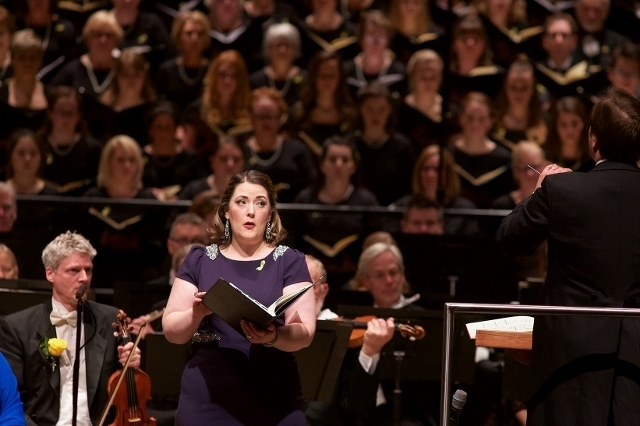German conductor Hans von Bülow coined the famous snap judgment of Giuseppe Verdi’s Requiem Mass: “an opera, though in ecclesiastical robes.”
Bülow skipped the 1874 premiere, but realized the error in his patronizing quip 18 years later when he was moved to tears during a modest parish performance. The irresistibility of Verdi’s work for chorus, orchestra and four vocal soloists lives in the world of possibility between its sacred origins and vast emotional depths.
On Friday night, Maestro Marcelo Lehninger explored that world as he led the Grand Rapids Symphony and, for the first time, the Grand Rapids Symphony Chorus. Some 275 musicians squeezed onto the DeVos Performance Hall stage to demonstrate how the grandiose, seven-part work can transcend the sum of its parts.
In a recent interview with WKAR, Lehninger said Verdi’s Requiem is one of his favorite pieces to conduct. Lehninger’s passion for the work was at the core of the performance on Friday night. Under his baton, the ensemble struck a fine balance between the music’s liturgical roots and raw theatricality. Lehninger constantly engaged with the 140-member Grand Rapids Symphony Chorus and drove the emotional energy forward, sculpting every tonal shift and phrase.
The chorus itself was superb — a credit to its director, Dr. Pearl Shangkuan. From hushed mystery in the opening “Introit and Kyrie,” to apocalyptic fury during the “Dies Irae,” to fleeting serenity in the “Libera me,” their voices held a balanced, disciplined sound with clear diction. The thrilling “Sanctus,” a double fugue for split choirs, was a high point.
Four guest soloists also contributed to the performance: soprano Julianna Di Giacomo, mezzo soprano Suzanne Hendrix, tenor Carl Tanner and bass Raymond Aceto. Most impressive was Di Giacomo, who performed Verdi’s Requiem with Gustavo Dudamel in 2014. On Friday, her opulent tone soared above the assembled forces. She was the most persuasive in expressing the fear of judgment and hope for redemption, particularly as she sang with increasing urgency during the “Libera me.”
Hendrix’s voice was a sumptuous, warm instrument that blended beautifully with Di Giacomo’s during the “Agnus dei,” and carried well over the orchestra during her solo with the chorus. At other times, such as in the “Lux aeterna,” it was understated and difficult to hear. Tanner, a substitution, was similarly underpowered during some sections, but exhibited all the unbridled heroism audiences love about operatic tenors during his “Ingemisco” solo.
Aceto offered a stentorian voice and striking stage presence. He supplied a dose of drama during his “Confutatis” solo, which he sang from memory. Moments of inconsistency were a small blot on the overall beauty these four artists created.
The GRS orchestra provided a strong foundation for the mood of each section, responding aptly at all the pivotal moments. Offstage brass fanfares brought a visceral edge to the “Dies irae,” as did Principal Percussionist Bill Vit’s bass drum thunderbolts. As Di Giacomo’s pleas grew more dire in the “Libera me,” the orchestra swelled to a powerful peak, then dissipated into a hushed, final prayer.
Lehninger lowered his baton at a glacial speed as the final chord faded. The audience’s reflective silence eventually grew to thunderous and lengthy applause, rewarding the musicians for a powerful traversal of dramatic contrasts.





